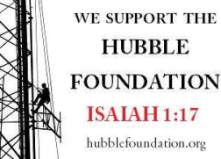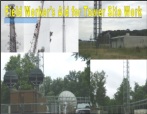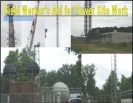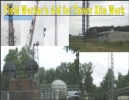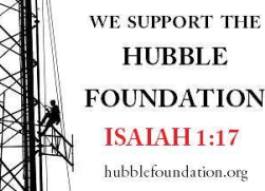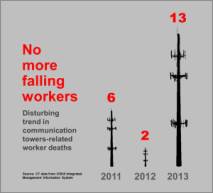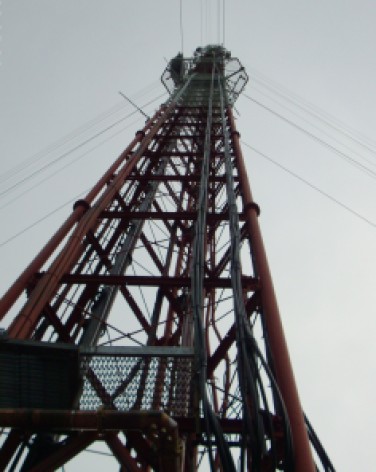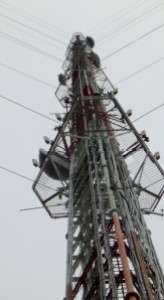Podcast: Play in new window | Download | Embed
Subscribe: Apple Podcasts | RSS
I was corresponding with Gette Hester, she works with climbers through the Hubble Foundation, and she is looking for feedback from tower climbers. This is your chance to let her know if you have been affected by RF radiation.
Listen to iTunes or Stitcher for more commentary! Podcast Download
If you recall I have done several podcasts and posts about RF radiation. I interviewed Bruce Elle, a great guy that was severely affected by RF Radiation, blog here and podcast here. Then I have feedback on that show, blog here and podcast here. I talk about RF radiation in several post, one is in the rooftop hazards post where I point out that it could be a real threat die to little vertical separation. Finally, more posted here on RF radiation and RF Awareness.
Go to the IWCE conference and see me! I will be on the “Tower Safety and Regulatory Compliance” panel on March 17th, 2015. Don’t you need an excuse to go to the Las Vegas convention center. I will share the stage with Cory Crenshaw, Charles Ryan, Dr. Denis Boulais, and Robert Johnson. Our moderator will be J. Sharpe Smith of AGL Magazine. Here is a list of exhibitors that will be there. I will be speaking and I may need some safety gear, email me at wade4wireless@gmail.com so we can talk! Make sure you sign up for this forum running 1:00PM to 4:30PM because let’s face it, these are issues you deal with on every job!If you want to talk after the conference, let me know.
Gette is doing research on how RF will affect climbers. This study will take time and the more feedback she gets the better the data and more accurate we can be. To quote what she is looking for, this is from her email to me.
“During this year, I am going to be devoting quite a bit of time the studying RF Radiation in telecom, hazards, mental, and physical health effects, etc…. I think this is a much more severe problem than most climbers realize. Sadly, I think it is probably a bigger issue than most employers care to admit to themselves or their workers. I was wondering if you could tell me a few things and then pass the email and my address on to some other climbers you think might have also had experience with RF. I am on a general finding mission as it were, and am trying to gauge the climbers in so far as the kinds of experience they have had with RF.
From my preliminary understanding of RF and the information I have been given as well as what I have researched on my own, it is entirely possible that climbers (as well as other at height workers) could be injured by radio frequency radiation and may not even know it. There seems to be research out there that indicates that some of the symptoms are both physical and mental. Excessive exposure to RF from transmitting antennas is dangerous to humans and could impact your tower climbing safety.
Have you ever worked around RF radio transmitters mounted on buildings, communication towers, light poles, water tanks, utility poles or otherwise?
Do you have any symptoms like depression, headaches, memory loss, mood disorders, sleep disorders or otherwise?
Are you familiar with or had any RF training?
How complete was that training?
Are you aware of the RF footprint surrounding antennas?
Have you worked near live antennas?
Do you think you may have been injured from RF radiation?
Your responses are important because it appears that there is a lack of RF exposure training and there very little knowledge by tower climbers of what exposure to RF radiation can do to humans.
If you think you could have been affected by RF, I would also like to talk to you briefly about your experience. In addition, PLEASE FEEL FREE TO PASS THIS REQUEST ALONG TO ANYONE YOU KNOW OF THAT WORKS AT HEIGHTS/ OR AROUND RFR!!! I greatly appreciate your assistance!!!!”
So there you go, she is looking for feedback and assistance. Does RF make you sick? Has it ever? Let her know! Reach out to her at bridgette@hubblefoundation.org if you wish to participate and help the future of this industry.
Start learning with some products I created just for you! Start with the Introduction to Tower Climbing, then get The Field Worker’s Aid for Tower Site Work, then to do the work you need to look at the Scope of Work Training, and finally the Tower Worker’s Logbook to log your high time and drive time and your project responsibilities, go to Learn more about my products! for more information!
This is probably a good time to talk about RF sensors. I was talking with someone from RSI corporation and they were telling me about the RF detection devices that they have. I know that this should be part of you standard safety gear, but is it? Do you really have something on you every time you go in the air? They are very expensive and I know that if you are doing LTE builds you may not see the need. Maybe this is another device that you should have on you at all times. Do you tie off 100% of the time like you are supposed too? Be honest! Do you? Why not protect yourself from RF as well.
If you are interested in RF detection devices, go to RSI’s website to learn more. I would like to do a comparison of these products, if anyone has more information, let me know. I know that the FCC has mandated RF awareness training, as stated in this LBA blog so you really need to be trained on the hazard. If you don’t think it’s a big deal, remember when the FCC fined Verizon Wireless?For more information go to my post about RF Awareness or my podcast.
So, if you have been affected by RF then it would be a good idea to reach out to Gette Hester of the Hubble Foundation., bridgette@hubblefoundation.org if you think you can help.
Be smart, be safe, pay attention! Follow the plan but be ready to improvise so you can adapt and overcome!
So what do you think doing the RF study? Let me know!



